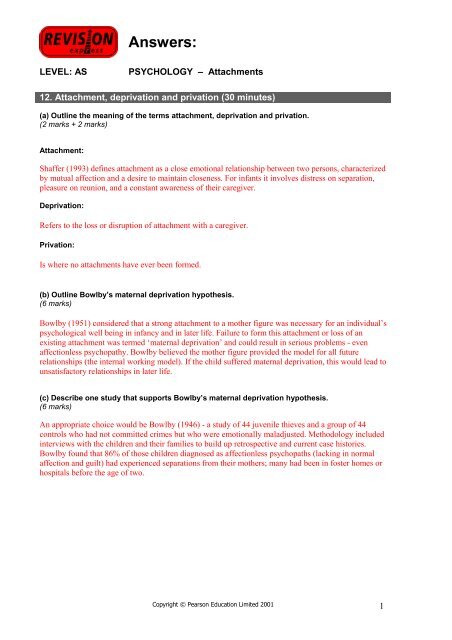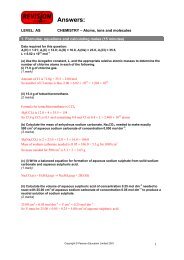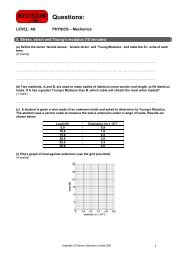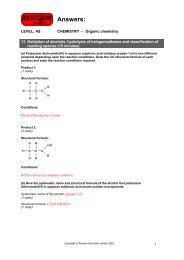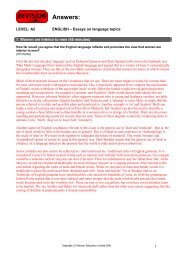Attachment, deprivation and privation - Pearson
Attachment, deprivation and privation - Pearson
Attachment, deprivation and privation - Pearson
You also want an ePaper? Increase the reach of your titles
YUMPU automatically turns print PDFs into web optimized ePapers that Google loves.
Answers:LEVEL: ASPSYCHOLOGY – <strong>Attachment</strong>s12. <strong>Attachment</strong>, <strong>de<strong>privation</strong></strong> <strong>and</strong> <strong>privation</strong> (30 minutes)(a) Outline the meaning of the terms attachment, <strong>de<strong>privation</strong></strong> <strong>and</strong> <strong>privation</strong>.(2 marks + 2 marks)<strong>Attachment</strong>:Shaffer (1993) defines attachment as a close emotional relationship between two persons, characterizedby mutual affection <strong>and</strong> a desire to maintain closeness. For infants it involves distress on separation,pleasure on reunion, <strong>and</strong> a constant awareness of their caregiver.De<strong>privation</strong>:Refers to the loss or disruption of attachment with a caregiver.Privation:Is where no attachments have ever been formed.(b) Outline Bowlby’s maternal <strong>de<strong>privation</strong></strong> hypothesis.(6 marks)Bowlby (1951) considered that a strong attachment to a mother figure was necessary for an individual’spsychological well being in infancy <strong>and</strong> in later life. Failure to form this attachment or loss of anexisting attachment was termed ‘maternal <strong>de<strong>privation</strong></strong>’ <strong>and</strong> could result in serious problems - evenaffectionless psychopathy. Bowlby believed the mother figure provided the model for all futurerelationships (the internal working model). If the child suffered maternal <strong>de<strong>privation</strong></strong>, this would lead tounsatisfactory relationships in later life.(c) Describe one study that supports Bowlby’s maternal <strong>de<strong>privation</strong></strong> hypothesis.(6 marks)An appropriate choice would be Bowlby (1946) - a study of 44 juvenile thieves <strong>and</strong> a group of 44controls who had not committed crimes but who were emotionally maladjusted. Methodology includedinterviews with the children <strong>and</strong> their families to build up retrospective <strong>and</strong> current case histories.Bowlby found that 86% of those children diagnosed as affectionless psychopaths (lacking in normalaffection <strong>and</strong> guilt) had experienced separations from their mothers; many had been in foster homes orhospitals before the age of two.Copyright © <strong>Pearson</strong> Education Limited 2001 1
Answers:LEVEL: ASPSYCHOLOGY – <strong>Attachment</strong>s(d) ‘Prolonged <strong>de<strong>privation</strong></strong> of a young child of maternal care may have grave <strong>and</strong> far reachingeffects on his character.’With reference to empirical evidence, evaluate Bowlby’s maternal <strong>de<strong>privation</strong></strong> hypothesis.(12 marks)There are several weaknesses in Bowlby's 44 thieves study. Early separation <strong>and</strong> later psychologicalproblems may be linked but correlation techniques are never proof of cause <strong>and</strong> effect. Rutter et al(1976) studied 2000, 9-12 year-old boys <strong>and</strong> found that early separation <strong>and</strong> maladjustment may bothbe caused by family discord. Boys were 400% more likely to be delinquent if separation was related tofamily discord rather than sickness or death of the mother. Furthermore, the information on separationfrom caregivers was collected by Bowlby retrospectively <strong>and</strong> hence may be unreliable. It is alsodifficult to envisage how the very short separations which characterized some of the children in hisstudy could cause psychopathic disorders. Indeed, diagnosis of affectionless psychopathy was made byBowlby himself, <strong>and</strong> his expectations may have biased the outcome. However, Bowlby's theory issupported by other empirical findings. Douglas (1975) analysed data from a longitudinal study of 5000children collected as part of the National Survey of Health <strong>and</strong> Development. Children who had spentmore than a week in hospital, or experienced repeated admissions under the age of four, had increasedchances of behavioural or reading difficulties in adolescence. Some researchers, however, consideerthat it was not separation alone that was responsible for these findings, but its combination with theanxiety generated by hospital residence.Spitz <strong>and</strong> Wolf (1946) studied 100 children who became depressed after they were separated fromcaregivers by hospital admission. They noted that the children generally recovered if the separation wasshort (< 3 months), but they rarely recovered fully if separations were longer.Rutter et al (1998) looked at the development of 111 Romanian orphans adopted by UK parents. Onarrival in the UK they were physically <strong>and</strong> mentally underdeveloped. However, by four years they hadall improved, although the children adopted later improved more slowly. There is evidence thatsuggests, therefore, that recovery from <strong>de<strong>privation</strong></strong> is possible with the provision of good quality care.It is necessary to distinguish between <strong>de<strong>privation</strong></strong> <strong>and</strong> <strong>privation</strong>, it is the latter which is likely to havelonger lasting consequences. Individual differences are also important some children being moreresilient to the possible harm caused by early <strong>de<strong>privation</strong></strong> or <strong>privation</strong>.(Total marks 30)Copyright © <strong>Pearson</strong> Education Limited 2001 2


